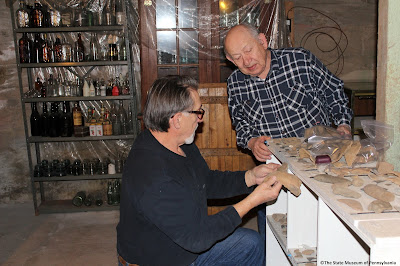This week in Pennsylvania
archaeology we are visiting some old friends and familiar collections. At the
end of last week a few of the Section of Archaeology staff set out toward
Milford, Pa, where they spent two days conscientiously packing up, long time
collector and educator, Bill Leiser’s artifact collection from several eastern Pennsylvania
sites. Mr. Leiser is a retired middle school science teacher, who collected on
sites in the Upper Delaware River Valley for over 50 years and has spent time
in his retirement continuing to educate students on prehistoric life in
Pennsylvania and the importance of archaeology and record keeping.
Mr. Leiser with a reconstructed pot and stone tools from the Santos site.
Mr. Leiser discussing site information and artifacts with staff member as
we work to safely bag and box up the artifacts.
Mr. Leiser is a dedicated and
knowledgeable avocational archaeologist who has devoted a lot of his time to excavating,
curating and sharing his collections. Working alongside other avocational
archaeologists such as David Werner, William DeGraw and a former student of Mr.
Leiser’s- Fred Assmus these men honed their excavation and mapping skills. Fred
Kinsey who was a curator with the William Penn Memorial Museum (now the State
Museum of Pennsylvania) and later at the North Museum at Franklin and Marshall
College in Lancaster, provided guidance to these former members of the Society
for Pennsylvania Archaeology, Lenape Chapter 12. Bill gleaned invaluable
knowledge on recording and mapping sites and continued to keep detailed records
on his own excavations. You may remember from previous blog posts (Pike County,
The Werner
Collection, and In
Memorium, Fredrick Assmus January 6, 1946-October 14, 2012) these other
members of Chapter 12 have also donated their collections to the Section of
Archaeology, which included most of the Zimmermann site (36Pi14) artifacts. Thanks
to Mr. Leiser’s donation we believe we have completed our acquisition of all of
the available Zimmermann site collection, which as has been mentioned in
previous blogs is a large, well-documented site due to the efforts of Mr.
Werner, Mr. Leiser, Mr. DeGraw and Mr. Assmus (Collecting
in Archaeology).
A few of the Zimmermann site artifacts in Mr. Leiser’s collection.
One of the many shelving units and cases that Mr. Leiser safely kept his
collections.
Along with excavating and
collecting at the Zimmermann site, Mr. Leiser also collected on numerous other
sites. Some of these other sites include the Santos site (36Pi37 and 36Pi02)
and the Ludwig/Pitman site (36Pi19), both of which are large multi-component
sites with numerous artifacts covering a large span of time. As he learned from
the Zimmermann site, Mr. Leiser continued to take copious notes, create maps of
the excavation units and organized the artifacts in such a way that he retained
the unit and level information for each one. It is this extensive work that
lends to these collections true value as exceptional research sources and great
tools to furthering our understanding of the history/prehistory of this region.
Example of some of Mr. Leiser’s notes and maps for the Santos site.
Example of how Mr. Leiser kept artifacts organized by site, unit and
level.
Bill and James with a few artifacts from the Santos site.
With the help of Bill and his son
James, archaeology staff were able to safely pack and transport Mr. Leiser’s
collection to The State Museum of Pennsylvania, Section of Archaeology. We will
begin to process Mr. Leiser’s collection into our cataloging and inventory
system. This process allows us to prepare the collection for future researchers.
The inventory process encompasses current point and ceramic nomenclature
facilitating an opportunity to further comparative research into these recently
acquired collections from the Upper Delaware. We thank Mr. Leiser for his
hospitality, diligence and efforts to help preserve these all-important pieces
of our past.
Upcoming events:
Dr. Kurt Carr will be sharing research related to the
recently reprinted book Indian Paths of Pennsylvania,
Paul Wallace, 2018, this weekend at the Lehigh Valley Heritage Museum https://www.discoverlehighvalley.com/event/indian-paths-of-pennsylvania/55608/
Archaeologists understand the
importance of sharing our research with the community and offer a variety of
venues for avocational and professional archaeologists to present their
findings. Every spring there is a flurry of conferences available for the general
public to attend and share in these discoveries. For those who would like to
attend, the Middle Atlantic Archaeological Conference (MAAC) is being held in
Ocean City, Md this year from March 21st – 24th. For the
program and other additional information on the meeting please visit the
website here: MAAC 2019.
Online registration is closed, but walk-in registration is available.
Another
opportunity to hear about the archaeology of Pennsylvania is the Society for
Pennsylvania Archaeology (SPA) annual meeting being held in Uniontown, Pa on
April 5th – 7th. For additional information please visit
the SPA annual meeting website at: http://www.pennsylvaniaarchaeology.com/AnnualMeeting.htm
. We hope to see you at one of the spring meetings or at one of the speaking
engagements of our staff. Please take some time to read about the
archaeological heritage of our commonwealth and the lessons that archaeology
can provide for the future. Follow the example of Bill Leiser and his friends to
record archaeological sites that you may know about. Remember this is your heritage and it is our
duty as citizens to strive to preserve
the past for the future.







No comments:
Post a Comment